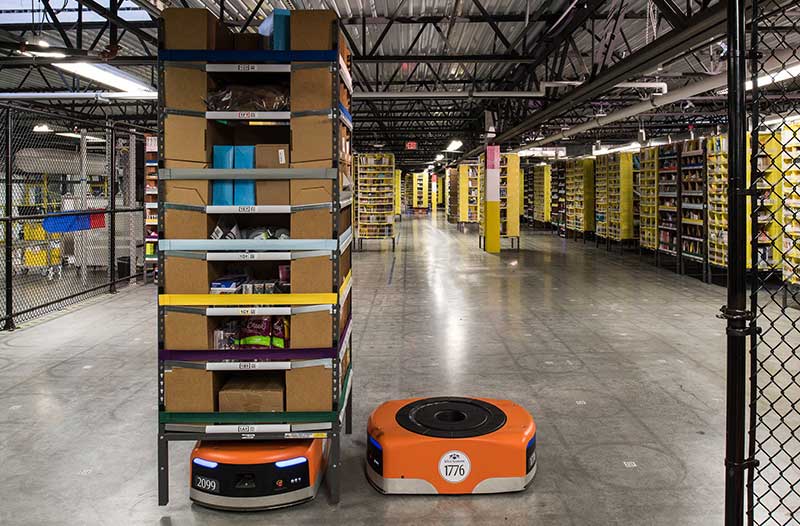- Behold, the world’s first fully robot-operated warehouse
- Perfectly predictable systems work with millimeter precision
- Will warehouses ever be completely humanless?
Robotic technology has come a long way since its humble beginnings, and it’s slowly starting to permeate every aspect of our society. Today, you’d be hard pressed to find a sector that doesn’t feature at least some degree of automation, and warehouses are no exception. Most warehouse work involves repetitive, time-consuming tasks that are easy to automate, so it’s not at all surprising that warehouses were among the first to succumb to the robotic revolution. Robotic technology provides numerous benefits for everyone involved, allowing companies to improve their efficiency, increase workplace safety, and reduce costs, while at the same time enabling workers to switch to more valuable jobs and leave the mundane, repetitive tasks to robots.
Behold, the world’s first fully robot-operated warehouse
The Chinese e-commerce giant JD.com recently announced the opening of a new, 40,000-square-metre warehouse in Shanghai. What makes this particular warehouse special is that it’s the first fully automated warehouse in the world, operated entirely by robots. The robots perform all of the tasks that used to be reserved exclusively for human workers, including lifting, packing, and transporting packages to loading docks and trucks. What about humans, though? Ordinarily, a warehouse of this size would employ somewhere between 400 and 500 human workers. However, that’s not the case here. JD.com’s new warehouse employs only five human workers who aren’t even involved in any warehouse operations. Instead, they’re only there to oversee and service the robots. In the future, those five may be gone as well. “I hope my company would be 100 percent automation someday,” says Richard Liu, JD.com’s chief executive. “No human beings anymore.”

Perfectly predictable systems work with millimeter precision
The robots were developed by MUJIN, a Tokyo-based startup that aims to be a leader in automating logistics processes. The company has developed robot controllers and camera systems that can be integrated with robotic hardware from any existing manufacturer. Approximately the size of a briefcase, the controller acts as an operating system that automatically controls the movement of the robot using motion planning and computer vision. Instead of relying on deep learning techniques, where robots learn to perform tasks through trial and error, MUJIN’s robots use a model-based approach to robotics, in which they’re explicitly programmed to perform a very specific task. This approach, where every position of every joint is tracked down to the millimetre, places enormous computational strain on the controller. So, to allow it to evaluate tens of thousands of possible moves and pick the optimal one within a second, the company had to equip the controllers with incredibly fast microchips. “The approach is like that of a train, plane or rocket — you don’t want it to be self-learning, just predictable when it goes from A to B,” says Rosen Diankov, MUJIN’s co-founder and CTO. “That’s how you create innovation, with perfectly predictable systems. That’s what we’re trying to do with robotics. I like to call this machine intelligence, not artificial intelligence.”
According to a JD.com spokesperson, the robots process approximately 200,000 packages each day and the company plans to expand the service to its other warehouses in China, Thailand, and Indonesia. The idea is to reduce the number of employees from 160,000 to just under 8,000, who will be paid better and work less. On the other hand, Diankov hopes that his company will soon be able to expand its operations to the United States as well, where robotic technology hasn’t been met with as much enthusiasm as in Asia. “We’re at the cusp where all these different automation technologies — including robot hardware, sensing hardware, AI algorithms, conveyor systems and sorting systems — are coming together,” says Diankov. “Five years ago it was not possible, because there were too many unknowns. But today there’s a solution for each of these different components in the warehouse. And now it’s a race to see which company puts all the components together the fastest and has the best end result. There are several choices for each component, and the jury’s still out on what a completely automated warehouse will look like.”
Will warehouses ever be completely humanless?
The biggest concerns about robotic technology and automation revolve around their impact on human workers. Are robots here to help us do our jobs or are they here to steal those jobs away from us? This has been one of the most hotly contested debates in recent years, and it’s not likely to die down anytime soon. If anything, developments like these are only going to add fuel to the fire. For the most part, experts agree that robotic technology will be extremely disruptive, but their predictions vary when it comes to the scale of the disruption. For example, the McKinsey Global Institute estimates that nearly half of the existing work activities could be automated, and that by 2030, anywhere between 400 and 800 million people will be forced to look for another job. However, Diankov believes that their technology will benefit humans in the long run. “Introducing robots creates more jobs, and history has shown that’s been the case,” he says.
Robotic technology has advanced considerably in recent years, and it’s found its way into almost every industry. Increased automation has affected a wide variety of jobs, but this surging trend has been particularly hard on warehouse workers, whose tasks are usually highly repetitive and easy to automate. Some warehouses have gone so far as to get rid of human workers almost entirely. Still, it’s hard to imagine that warehouses will ever become completely humanless, as someone will probably always be needed to monitor and maintain the robots.
Share via:


